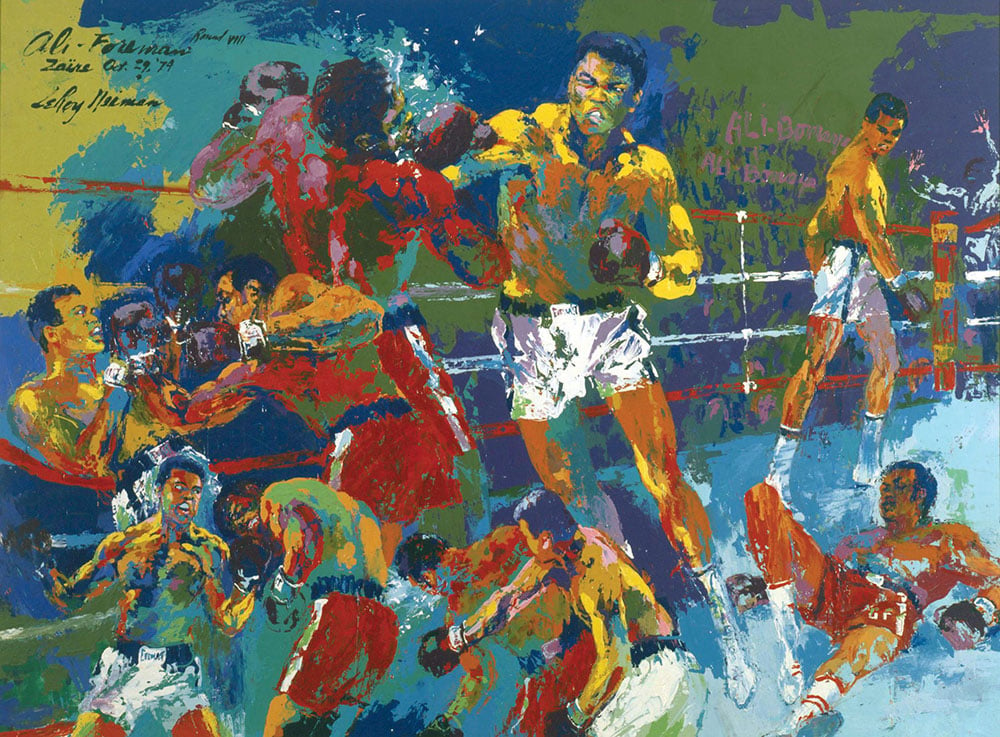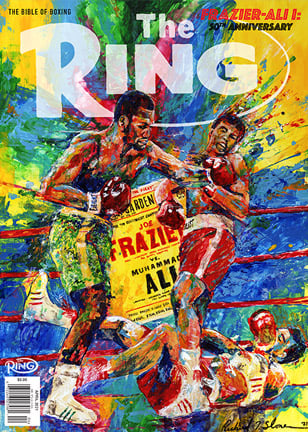
Above: The great Smokin’ Joe Frazier was both friend and mentor to our cover artist, Richard T. Slone.
SMOKE, BEES AND BUTTERFLIES
I met Joe Frazier at the Thomas A’Becket gym in London in 1989. I was down there working out (I was an amateur boxer) and Joe was in town promoting the documentary Champions Forever. He saw me hitting the bag, we got along really well, and just one year later I was in Philadelphia with him. As soon as I finished school, I flew to Philadelphia, signed up with him, and he started training me. I didn’t turn professional, but I stayed with Joe for 10 years.

One of Slone’s early tributes to Frazier.
We were the best of friends; he could discuss anything with me, and there was so much trust. His traits inside the ring – the intensity, the dedication – he also carried those outside the ring, too. Joe always stuck to his word; his word was his bond, and he did his best to be a great human being. He had so much willpower, so much character, and he didn’t fear anything. If someone was out of line, he didn’t respect that, whether it was his own blood or a stranger on the street. One of his famous quotes was, “There’s no right way to do wrong and no wrong way to do right.” I’ve said a few times he was the toughest man I ever met and the kindest man I ever met. You only come across someone like Joe once in a lifetime, and you could never wish for a better friend.
I met Muhammad Ali in 1992 in Tulsa, Oklahoma. I went to an event with Joe as his aide and Ali showed up without an aide, so I ended up helping him out, too. All three of us had to ride in a limo together from the airport to the hotel. I got to know Ali pretty well and, to this day, some of Ali’s family members are some of my best friends. Ali was an amazing person. Like Joe, he did a lot of things that people don’t know about in terms of charity work and things of that nature.
In the late ’60s, there was such a strong racial divide and there was the Vietnam War. Ali took one side. Joe never took any side, and Ali’s view on that was, “You’re not one of us!” Joe’s response was, “Hey, it’s my job to fight in the ring, and I don’t know anything about politics!” But after he retired from boxing, Ali became much more peaceful and humble. He really was a wonderful guy.
As fighters and attractions, they were totally different. Ali liked to be the pretty boy, and Joe didn’t care about any of that. Joe was a good-looking guy, too, but he was so humble about it. He would give away signed photographs of himself and say to people, “I’m so ugly, you can put that in the basement and it’ll scare away the rats.” Joe didn’t use the word “pretty” like Ali did. He had no vanity; he was a man’s man, and Ali was all about showmanship. But as different as they were, I really believed Ali when he said, “If God ever calls me to a holy war, I want Joe Frazier fighting beside me.”
“The Fight of the Century” was the perfect storm. It was the first major fight to draw women, the Hollywood contingent and politicians. Everybody who was somebody was there, or they were trying to be there. There was the glitz, the glamour, and you even had the biggest drug dealers in New York in the arena that night; Frank Lucas was there. You were either an Ali fan or a Frazier fan and, just like today, there was this tremendous conflict throughout the nation, which heightened the stakes. There’s never been an event like it. “The Thrilla in Manila” was a great fight, but in “The Fight of the Century,” they were both undefeated, both in their 20s, it was held at Madison Square Garden, and the stars aligned. That was Joe’s finest hour.

LeRoy Nieman’s iconic artwork for The Rumble in the Jungle.
This cover firstly pays homage to LeRoy Neiman, the official ringside artist in 1971, and I have utilized his color palette. LeRoy was a friend and he had a huge influence on me. He would have been 100 years old this coming June, so it’s a fitting tribute to accompany the 50th anniversary of “The Fight.” This cover is also the first time that I’ve painted Joe since he passed away on November 7, 2011. It’s just so difficult to paint him. As I sit here right now, the hair on the back of my neck is standing on end because it’s a chance for me to make him proud. He always had belief in me, he gave me so many opportunities, and to be part of this is one of my biggest honors. To be a pallbearer at his funeral was a massive honor, but this is massive for me, too. This is a painting that will stay in my collection forever; it comes from the soul, and it’s important for me because I knew both guys. In a way, it’s like painting family, it’s like painting a moment from childhood. It’s hard to find the words, but this tribute means so much to me.


